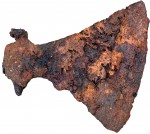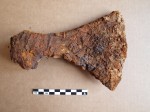 In 2012, highway construction in Hårup, southwest Denmark, unearthed an unusual grave. It’s a Viking tomb of a type known as a death house, a palisade structure similar to the simple roofed post-in-ground structures that would evolve into stave churches. This is the first death house found in Denmark. It measures four by thirteen meters (about 13 x 43 feet) and has one large room with two graves, and an addition that was built later to house one more grave. The death house dates to around 950 A.D.
In 2012, highway construction in Hårup, southwest Denmark, unearthed an unusual grave. It’s a Viking tomb of a type known as a death house, a palisade structure similar to the simple roofed post-in-ground structures that would evolve into stave churches. This is the first death house found in Denmark. It measures four by thirteen meters (about 13 x 43 feet) and has one large room with two graves, and an addition that was built later to house one more grave. The death house dates to around 950 A.D.
 Acidic soil has left no detectable human remains, but archaeologists were able to determine the gender of the people buried in the death house from their grave goods. In the main room are a man and woman, the former identified by a large battle axe that was called the Dane Axe in the 10th century. Its imposing size made it an intimidating and highly destructive weapon when wielded by an able fighter. Its weight and size made it a useful tool break apart enemy shields along their seams. In the 10th century, this would have been extremely expensive, an elite weapon for nobility or the obscenely wealthy.
Acidic soil has left no detectable human remains, but archaeologists were able to determine the gender of the people buried in the death house from their grave goods. In the main room are a man and woman, the former identified by a large battle axe that was called the Dane Axe in the 10th century. Its imposing size made it an intimidating and highly destructive weapon when wielded by an able fighter. Its weight and size made it a useful tool break apart enemy shields along their seams. In the 10th century, this would have been extremely expensive, an elite weapon for nobility or the obscenely wealthy.
 The second person in the main chamber was buried in a wooden wagon typical of burials of noble women. Buried with her were two keys, one larger one symbolic of her status as the lady of a great household. The second key fits a square box that was found by her feet. Fine accessories buried with her include gold and silver ribbon and fur. The person buried in the addition is also an adult male. He too was buried with an axe in his grave, only his was smaller.
The second person in the main chamber was buried in a wooden wagon typical of burials of noble women. Buried with her were two keys, one larger one symbolic of her status as the lady of a great household. The second key fits a square box that was found by her feet. Fine accessories buried with her include gold and silver ribbon and fur. The person buried in the addition is also an adult male. He too was buried with an axe in his grave, only his was smaller.
The special markings of the grave indicate that the pair must have had a high social status.
“It could be the gentlemen and the lady of the local area and maybe their successor. They’ve at least been honoured in a special way, so they must have been important,” says [excavation leader Kirsten Nelleman] Nielsen.
And it is not just the tomb that is special.
“It’s very special that the man and woman’s graves are marked by the same tomb or palisade. It’s unusual that we’re able to establish that the man and woman were equals with such certainty,” says Nielsen. […]
[A]rchaeologist Henriette Lyngstrøm from the University of Copenhagen, Denmark,… has seen examples of shared graves before, but the way that the men and women are laid in this grave does indeed indicate a powerful couple, she says.
 Nielsen thinks the design inspiration for the death house may have been foreign. The remains of a clay vessel found in the woman’s grave is of a type produced in the Baltic, and she also had two silver coins from what is now Afghanistan. The couple either acquired goods from traders who ranged far and wide or were perhaps well-travelled themselves. If the death house was inspired by a similar structure from elsewhere, that might explain why not other such tombs have been found in Denmark.
Nielsen thinks the design inspiration for the death house may have been foreign. The remains of a clay vessel found in the woman’s grave is of a type produced in the Baltic, and she also had two silver coins from what is now Afghanistan. The couple either acquired goods from traders who ranged far and wide or were perhaps well-travelled themselves. If the death house was inspired by a similar structure from elsewhere, that might explain why not other such tombs have been found in Denmark.
 Lyngstrøm believes there are more death houses in Denmark; they haven’t been found yet. Nobody was really looking for them. Perhaps this first discovery of its kind will stimulate archaeologists to make associations they haven’t previously made when excavating at tomb. For example a necropolis in Hornbæk, a coastal resort town in northeast Denmark, has the remains of structures at the entrances that may have been death houses, or at least a version of them.
Lyngstrøm believes there are more death houses in Denmark; they haven’t been found yet. Nobody was really looking for them. Perhaps this first discovery of its kind will stimulate archaeologists to make associations they haven’t previously made when excavating at tomb. For example a necropolis in Hornbæk, a coastal resort town in northeast Denmark, has the remains of structures at the entrances that may have been death houses, or at least a version of them.
The Silkeborg Museum is hosting an exhibition running through October 23rd that presents an overview of the discoveries made during the highway construction project. It includes the reconstruction of the woman’s grave, the grave goods and some of the other finds from the Stone Age to the 19th century.
I did not quite get why a Battle Axe found in a grave makes its former owner ‘obscenely wealthy‘. Weapons as grave goods are in fact nothing extraordinary in European warrior graves, probably beginning in the Bronze Age up to early Medieval periods.
The ‘death house’ certainly underlines a certain level of wealth, i.e. they were probably land owners. Furthermore, the death house could be interpreted as a ‘grave mound minus the mound’, meaning that if you take the mound away, there is in almost all the cases at least a ‘wooden construction’ underneath. Here, seemingly with no mound in the first place.
European society was based on agriculture and trade, and in raiding season of course on Viking ‘hostile takeovers’. Denmark alone has about 20,000 preserved burial mounds or ‘tumuli’, with the oldest being around 5000 years old.
Very interesting!